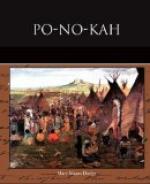AN INDIAN TALE OF LONG AGO
By Mary Mapes Dodge
1903
PO-NO-KAH.
An Indian story of long ago.
I.
The Hedden family.
We who live in comfortable country homes, secure from every invader, find it difficult to conceive the trials that beset the hardy pioneers who settled our Western country during the last century.
In those days, and for many a year afterward, hostile Indians swarmed in every direction, wherever the white man had made a clearing, or started a home for himself in the wilderness. Sometimes the pioneer would be unmolested, but oftener his days were full of anxiety and danger. Indeed, history tells of many a time when the settler, after leaving home in the morning in search of game for his happy household would return at night to find his family murdered or carried away and his cabin a mass of smoking ruins. Only in the comparatively crowded settlements, where strength was in numbers, could the white inhabitants hope for security—though bought at the price of constant vigilance and precaution.
In one of these settlements, where a few neatly whitewashed cabins, and rougher log huts, clustered on the banks of a bend in the Ohio River, dwelt a man named Hedden, with his wife and three children. His farm stretched further into the wilderness than his neighbors’, for his had been one of the first cabins built there, and his axe, ringing merrily through the long days, had hewn down an opening in the forest, afterward famous in that locality as “Neighbor Hedden’s Clearing.” Here he had planted and gathered his crops year after year, and in spite of annoyances from the Indians, who robbed his fields, and from bears, who sometimes visited his farm stock, his family had lived in security so long that, as the settlement grew, his wife sang at her work, and his little ones shouted at their play as merrily as though New York or Boston were within a stone’s throw. To be sure, the children were bidden never to stray far from home, especially at nightfall; and the crack of rifles ringing now and then through the forest paled their cheeks for an instant, as the thought of some shaggy bear, furious in his death agony, crossed their minds.
Sometimes, too, the children would whisper together of the fate of poor Annie Green, who, a few years before had been found killed in the forest; or their mother would tell them with pale lips of the night when their father and neighbor Freeman encountered two painted Indians near the cabin. The tomahawk of the Indian who tried to kill their father was still hanging upon the cabin wall.
But all this had happened twelve years earlier—before Bessie, the oldest girl, was born—and seemed to the children’s minds like a bit of ancient history—almost as far off as the exploits of Hannibal or Julius Caesar appear to us. So, as I have said, the girls and boys of the settlement shouted joyously at their play, or ran in merry groups to the rough log hut, called “The School-House,” little dreaming of the cares and anxieties of their elders.




